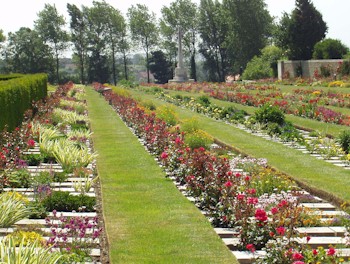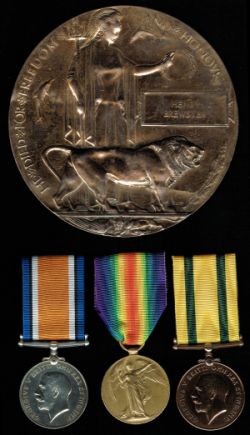|
|
| Home Topics Memorials Miscellany Transcripts References Family History Glossary Latest Beeston Blog About us | Site Search |
|
Harry Brewster, was born in Newark. Nottinghamshire in 18962, the fourth of seven surviving children of Joseph and Elizabeth (née Bellamy) Brewster. His father worked for much of his life as a blacksmith's striker in his birthplace, Newark, Nottinghamshire. Around 1901, however, the family had spend a few years living in Hull3 but soon moved back to Newark. In 1911, the family was living at Cawkwells Square, St Marks Lane, Newark and Joseph was back at his job as a striker with an implement maker - probably at Nicholsonís Trent Iron Works. Harry, then aged 15, had started work as a fishing tackle maker4. In the years just prior to the First World War, Harry had volunteered for service with the Notts & Derby Territorial Force and was attached to 5th Battalion. As such, Harry was mobilised within the first few days when War was declared on 4th August 1914, becoming part of 1/5th Battalion5, formed with men from the Territorial Force and stationed at Derby. The Battalion then moved to Harpenden, between Luton and St Albans in Hertfordshire, and then Braintree. Although 1/5th Battalion left for France in February 1915, it seems that Harry had, by then, been transferred to 2/6th Battalion which was stationed at Luton as part of the 178th Brigade of he 59th Division and later moved to Dunstable and Watford. It was from there, in April 1916, that the battalion was dispatched to Dublin. In August 1914 the political controversy of 'Home Rule' for Ireland had been put aside when the Great War overshadowed all differences between politicians, resulting in over 250,000 Irishmen of whatever belief pledging their allegiance to the Crown and the cause of patriotism. With the increasing food shortages however, the country districts prospered but in the towns the story was very different. The city of Dublin in particular felt the pinch of poverty, the price of food and products were ever increasing but with pre-war rates of pay for the workers, seeds of rebellion could be found. This was the situation then in 1916 when a number of intellectuals launched the idea that the time was right to strike a blow for autonomy. With the help of American money, arms were purchases from Europe and landed on the Irish Coast. On Easter Monday - April 24th - when many of the British troops stationed there were enjoying time off and many of their Officers were attending a local horse race meeting, a force of some three thousand or less took this opportunity to strike. The first shot fired by the rebels was outside Dublin Castle when a policeman was killed and this incident sparked off the rebellion. The rebels seized a number of places of strategic importance including St.Stephenís Green, the adjacent Jacob's Biscuit factory, Trinity College and the General Post Office in Sackville Street - from where Patrick Pearce, the insurgents leader, a headmaster from St. Edna's School, stood on the steps and declared an independent Irish Republic. Reinforcements, consisting of two inexperienced Infantry Brigades the 176th and 178th - which included the 2/5th, 2/6th, 2/7th and 2/8th Battalions of the Sherwood Foresters - were quickly sent by ship from Liverpool. It was only when they arrived at Kingston in Ireland on Wednesday 26th April that they learned that a rebellion had broken out in Dublin, and that the rebels were holding many of the principle buildings, with a view of preventing any soldiers from entering the city. Nevertheless, on a fine spring day, they moved off on two roads towards Dublin. As the first contingent - 2/7th & 2/8th - marched into Dublin, at Mount Street Bridge they came under fire from the rebels positioned in the buildings that they had taken. The men were particularly exposed and, having only the most basic rifle training, they suffered many casualties. The other two battalions - 2nd/5th and 2nd/6th - reached the city on the inland road without opposition and dispersed and took up sniping positions. Eventually, after a supply of grenades arrived, it was possible, at last, to take the rebel positions and to relieve the exhausted and demoralized 2nd/7th Battalion6. After the rebellion had been put down, Private Brewster with 2/5th Battalion moved to Curragh Camp where he remained until the end of 1916. On 26 December 1916, Harry married Daisy Croom at Beeston Parish Church, apparently during a period of leave. Daisy (b. 1895, Newark, Notts) was the daughter of Thomas and Catherine Croom, originally from Newark. By 1911, the Croom family had moved to Beeston and were living at 4 Union Street with Thomas and two of the sons working at Beeston Foundry. Daisy was then aged 15, working in a shoe shop7. Her sister Kate Elizabeth had married Harry's eldest brother Alfred. At least two of her brothers served in France during the war, Alfred was to survive but Henry had died from wounds in May 19158. It is clear that the Brewster and Croom families were close and, by the time of Daisy's marriage, the Bewsters had also moved to Beeston, to live at 34 Myrtle Grove with Joseph and his son Herbert both working at Beeston Foundry9. At some point, we appear to have no evidence when, Private Brewster was posted to France, possibly with his past battalion the 2/5th Battalion or with the 2/7th, both of which left for France in February 1917. As Harry and Daisy's only child - Peggy Brewster - was born on 22 March 191810, it seems also possible that his posting was later in 1917 - or he received additional leave. What does seem certain is that, by 1918, he was with 2/7th when, on 31 January, it amalgamated with 1/7th Battalion to become 7th Battalion. On 21st March, the German Army launched its Spring Offensive from the Hindenburg Line with the objective of ending the war before American troops and resources could tilt the balance towards the Allies. The objective was to smash through the Allied lines, push the British forces into the sea and to cut off their supply lines by seizing the ports. When the enemy attacked, 7th Battalion was in the trenches in the Noreuil region in the Pas-de-Calais. The German advance was preceded by a very heavy bombardment which started just before 5am and included gas shells as well as high-explosives. The communication wire was broken and the only contact with H.Q. that was possible was by pigeon. Only 14 men from the battalion escaped unwounded from the trenches and they reported that the enemy had broken through on both flanks and they were likely to be encircled. Those that could, including those men that had not been in the line, were banded together and sent up to defend the reserve line and, on the next day, moved back to Courcelles. Casualties had been very high, totaling 26 officers and 629 other ranks and the battalion strength was now only about 1/3 of what it had been at the beginning of March. The battalion's efforts, though costly in numbers, had been successful in delaying the enemy advance until reinforcements could be brought up11.
He was buried in the Boulogne Eastern Cemetery, one of the town cemeteries which stands on high ground on the eastern side of Boulogne, on the road to St. Omer. Boulogne was one of the three Base ports most extensively used by British armies on the Western Front, throughout the 1914-18 War. It was closed and cleared on 27th August 1914, in consequence of the retreat of the Allies; but was opened again in October and, from that month to the end of the war, Boulogne and Wimereux formed one of the chief Hospital areas. The dead from the Hospitals at Boulogne itself were buried until July 1918 in the Cimeteire de LíEast, one of the town Cemeteries. It was found the ground in the Eastern Cemetery was being filled up, in spite of repeated extensions to the south, and a new cemetery at Terlincthun was chosen.12 Private Brewster was posthumously awarded the British War Medal, Victory Medal and Territorial Force War Medal13 (shown right with his Death Plaque). His Army financial effects of £5 8s 11d were paid to his widow as his sole legatee, on 19 August 1919 and she received his War Gratuity of £17 10s on 18 December 1919.14. In 1919, Daisy Brewster married Frank E Howett and they lived out their lives in Hawton Crescent in the Wollaton area of Nottingham. Daisy died in Nottingham in 1968, aged 73. Peggy Brewster married Edward A William in 1938 and they had one child. She later married Robert L Crofts and lived in Bramcote, Notts up to her death in 2003. Joseph and Elizabeth Brewster continued to live at 34 Myrtle Grove, Beeston for the remainder of their lives, Elizabeth died in 1931, aged 59 and Joseph in 1932, aged 6915. Footnotes 1The photograph of Boulogne Eastern Cemetery is from the Commonwealth War Graves Commission website. (http://www.cwgc.org) 2His birth was registered in Newark Registration District in Q4/1896 (Ref 7b 441). He is recorded as 'Henry' in his Army records. 3Hull, Yorkshire : 1901 Census - Piece 4505 Folio 97 - 12 Alfreds Terrace 4Newark, Notts : 1911 Census - Piece 20735 RD432, SD3, ED4, Sched 88. His siblings were Alfred (b. c1890), Lucy (b. c1892), William (b. c1894), Joseph (b. 1900), Herbert (b. c1905) and Irene (b. c1909). Two others died as infants. 5His approximate enlistment date is calculated from his War Gratuity. His service with the pre-war Territorial Force is from his Medal Card which records his award of the Territorial Force War Medal and attachment to 1/5th Battalion (Service No. 1733). 6There is another account of this tragic encounter at www.crich-memorial.org.uk/sherwoodforesters.html 7Beeston, Notts : 1911 Census - Piece 20431 RD429, SD3, ED6, Sched 131 8Henry Croom's memorial page may be seen here. 9Both Joseph and Herbert are recorded as employees and living at the Myrtle Grove address in the Beeston Boiler Company records. 10Peggy's birth was registered in Basford Registration District (of which Beeston was part) in Q1/1918 (Ref 7b 448). Her exact date of birth is recorded in the 1939 Registration and on her death registration. 11This summary of the battalion's actions in March/April 1918 is based on its War Diary (available on ancestry.com). 12This description of Boulogne Eastern Cemetery is based on that on the Commonwealth War Graves Commission website. (http://www.cwgc.org) 13Details from Harry's Medal Card - available on ancestry.com. The medals and Death Plaque are now in the possession of Paul Brewster, who has kindly supplied the photograph. 14Details of the payments are from the "Army Register of Soldiers' Effects, 1901-1929" - available on ancestry.com. 15Details from standard genealogical sources, including the 1939 Registration and Electoral Rolls. |
|
|||||||||||
|
|
|||||||||||||

 At some point, either as part of the heavy casualties on the 21/22nd March or during the several less intensive episodes in the front line in April, Private Brewster was wounded and passed through the evacuation chain, probably
reaching one of the hospitals in the Boulogne area. Despite all efforts, he died from his wounds on 28th April 1918. It is not known whether he received the news of his daughter's birth.
At some point, either as part of the heavy casualties on the 21/22nd March or during the several less intensive episodes in the front line in April, Private Brewster was wounded and passed through the evacuation chain, probably
reaching one of the hospitals in the Boulogne area. Despite all efforts, he died from his wounds on 28th April 1918. It is not known whether he received the news of his daughter's birth.